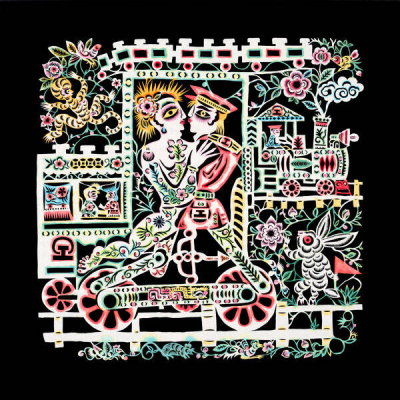纽约时报中文网 - 中英对照版-中英禁忌中的烈欲中国酷儿艺术家西亚蝶在剪纸中追寻自由
March 22, 2024 5 min 922 words
这篇报道以艺术家西亚蝶的个人经历,深入探讨了中国酷儿艺术、性取向与传统社会习俗之间的冲突与融合。西亚蝶以传统剪纸艺术为载体,表达出对自由的渴望,对性取向的坦然接受,以及对社会禁锢的反抗,他的作品不仅仅是艺术创作,更是他个人生活经历与情感的真实写照。他的故事让我们看到,艺术是超越性别、年龄、文化、社会习俗的束缚,追求个人自由与真我表达的重要途径。同时,他的经历也反映了中国社会对于性取向认知的演变,以及艺术对于社会进步的推动作用。
In the years he hid his sexuality from his children and village neighbors, Xiyadie would take short-bladed scissors to rice paper and give shape to unfulfilled dreams.
在向子女和村邻隐瞒自己的性取向的那些日子里,西亚蝶会用小剪刀剪宣纸,给未曾实现的梦想赋予形状。
At first glance, his creations conform to traditional cutout designs of animals and auspicious symbols adorning doorways and windows in China. But a closer look at the shapes — birds, butterflies and blossoms perched on twisty vines — reveals bodies conjoined in the throes of intimacy or separated by brick walls.
乍一看,他的作品与装饰门窗的中国传统剪纸并无二致,都是动物和各种吉祥图案。但仔细观察这些小鸟、蝴蝶和在缠绕藤蔓上绽放的花朵,你就会发现,人体或在烈欲中结合,或被砖墙远远隔开。
The artist, 60, who goes by the pseudonym Xiyadie, was born in a farming village in northern China, and he creates queer paper cuts. Paper cutting is a folk tradition dating from the Eastern Han dynasty (25-220 C.E.) that involves cutting crisp lines and shapes into folded layers of rice paper. It’s about excising the negative space to reveal the picture inside.
西亚蝶是这位现年60岁的艺术家的化名,他出生于中国北方的一个务农家庭,创作酷儿剪纸作品。剪纸是源自东汉时期(公元25-220年)的民间传统,在折叠的宣纸上剪出清晰的线条和形状。剪纸是把空白的地方剪掉,呈现出里面的画面。
Xiyadie’s home province of Shaanxi was a hub for folk art; in his hometown, paper cuts marked births, weddings and Lunar New Year celebrations. The women in the village passed on the craft to their daughters and daughters-in-law. Xiyadie said he learned it by observing his mother and village matriarchs.
西亚蝶的家乡陕西省是民间艺术的重镇;在那里,生子、婚嫁和庆祝春节都少不了剪纸。村里的妇女会把这门手艺传给女儿和儿媳。西亚蝶说,他是通过观察母亲和村里的年长女性学会这门手艺的。
He mostly cut freehand, sometimes using indentations he made with his fingernails as outlines, then dyed his creations with green, pink, red and yellow pigments. He began making homoerotic paper cuts in the 1980s as he struggled with his closeted sexuality, but for many years he kept these works to himself.
他的作品大多是徒手剪纸,有时用指甲压出的凹痕作为轮廓,然后用绿色、粉色、红色和黄色颜料染色。他一直因为自己隐蔽的性取向而挣扎,自20世纪80年代起,他开始创作同性恋主题的剪纸作品,但多年未曾将这些作品示人。
Until 1997, gay people in China risked being persecuted; homosexuality was not removed from the official list of mental disorders, maintained by the Chinese Society of Psychiatry, until 2001.
1997年之前,中国的同性恋者面临着迫害风险;直到2001年,中国精神病学会才将同性恋从官方精神疾病名单中删除。
“I put the feelings for men that I was not allowed to have into my creations,” he said in a phone interview.
他在接受电话采访时说:“我把不允许我拥有的对男性的感情融入了创作中。”
In China, many artists who have found success have formal training from elite art academies, and the most visible queer artists tend to come from comparatively privileged urban backgrounds, said Mimi Chun, founder and director of Blindspot Gallery in Hong Kong. By contrast, Xiyadie creates elaborate scenes from his time as a closeted farmer and then as a migrant worker cruising in China’s capital city.
香港刺点画廊的创办人及总监秦美娜说,在中国,许多获得成功的艺术家都受过精英艺术院校的正规教育,而最引人注目的酷儿艺术家往往来自相对优越的城市背景。相比之下,西亚蝶创作的复杂景象来自于他作为一个隐瞒性取向的农民,以及后来作为在首都游荡的外来务工者的生活。
“He bridges folk art and queerness, and builds a dialogue between these two very disparate worlds,” she added.
秦美娜还说:“他在民间艺术和酷儿之间架起了一座桥梁,并在这两个截然不同的世界之间建立了对话。”
The gallery will display more than 30 of his works in the show “Xiyadie: Butterfly Dream,” with an opening reception and an artist talk on Saturday. The show continues on Monday, and runs through May 11. The pieces connect different chapters in his life, including one of his first sexual encounters.
刺点画廊将在“西亚蝶:蝶梦”展览中展出他的30多件作品,周六将举办开幕酒会和艺术家座谈会。展览将于下周一继续,一直持续到5月11日。这些作品连接了西亚蝶生命中的不同篇章,包括他的首次性经历。
“Train” (1986) shows Xiyadie locked in embrace with a uniformed attendant, the figures’ legs moving in tandem with the coupling rods. A verdant backdrop surrounds them, as if to underscore the natural order of his tryst; a rabbit raises a victorious red flag in celebration.
《火车》(1985-1986年)表现的是西亚蝶与一名身着制服的服务员紧紧相拥,人物的双腿随着火车联杆一起摇动。青翠的背景环绕着他们,似乎在强调他们的爱恋是自然而然的;一只兔子举起胜利的红旗以示庆祝。
“The flowers and leaves, the sun, moon and the birds are all part of my lingua franca — they convey my deepest thoughts,” Xiyadie said.
“花叶、太阳、月亮和飞鸟都是我的语言,它们传递着我最深沉的思想,”西亚蝶说。
Xiyadie married a woman at the behest of his family, he said. They had two children, and their son was paralyzed by cerebral palsy. For some years, Xiyadie cared for the children at home while his wife worked at a hospital. The filmmaker Sha Qing documented the family’s struggles in a 2002 documentary, “Wellspring,” years before Xiyadie became known as an artist.
他说,他在家人的要求下和一个女人结了婚。他们有两个孩子,儿子因脑瘫而瘫痪。许多年来,西亚蝶在家里照顾孩子,他的妻子在医院工作。多年前,在西亚蝶还没有成为知名艺术家的时候,电影制片人沙青在2002年的纪录片《在一起的时光》中记录了这个家庭的挣扎。
Xiyadie described the early years of his marriage as a charade he could not exit. Towering walls or doors separated his domestic life from his furtive trysts or fantasies. In “Sewn” (1999), he is trapped inside a house with a traditional tiled roof. While gazing at a photograph of his lover from the train (a recurring figure in his work), he sits atop a sword lying on its side and sews up his genitals, then pierces the roof with the giant sewing needle.
西亚蝶将他婚姻的早些年描述为一场无法逃脱的骗局。高耸的墙壁或大门将他的家庭生活与偷偷摸摸的幽会或幻想隔开。在《缝纫》(1999年)中,他被困在一座传统瓦房里。当他凝视着那位火车上的情人的照片时(这位情人在他作品中经常出现),他坐在一把侧卧的剑上,用针缝合自己的生殖器,这根巨大的缝衣针刺穿了屋顶。
“I kept wanting to break through tradition and convention,” he said. “I wanted freedom. I wanted liberation.”
“我不停地想打破传统和习俗,”他说。“我想要自由。我想要解放。”
Years later, in 2005, he moved to Beijing in search of higher earnings and more artistic opportunities, discovering a vibrant gay community in the process. His family stayed in their hometown, but his son moved to live with him in 2013 for better medical treatment in the capital.
多年后,在2005年,他来到北京寻求更高的收入和更多的艺术机遇,并在此过程中发现了一个充满活力的同性亚文化圈。他的家人留在了家乡,但为了获得首都更好的医疗条件,儿子于2013年搬来与他同住。
He began using the city’s cruising spaces as backdrops in his work, depicting dance-like trysts and ecstatic orgies in parks.
他开始在作品中以城市的猎艳空间为背景,描绘公园里舞蹈般的幽会和狂欢的多人性爱。
“Coming to Beijing, I felt like a frozen butterfly flying toward spring,” he said.
“来到北京,我感觉像一只被冰冻的蝴蝶飞向春天,”他说。
He gained a following among queer art collectors in Beijing, and his 2010 debut at the now-shuttered Beijing LGBT Center has led to exhibitions in Europe, Asia and the United States, including a 2023 solo exhibition at the Drawing Center in New York. The pseudonym he chose after he began to exhibit his art, Xiyadie, translates to “Siberian Butterfly,” referencing the drafty cold of his hometown and the resilience it takes to pursue freedom.
西亚蝶在北京的同性恋艺术收藏家中获得了一批追随者,2010年在现已关闭的北京同志中心首次展出后,他在欧洲、亚洲和美国举办了多次展览,其中包括2023年在纽约绘画中心举办的个展。他开始展出自己的艺术作品后选择的化名“西亚蝶”意为“西伯利亚的蝴蝶”,象征着他家乡刺骨的寒冷,以及追求自由所需要的坚韧。
“From the beginning, I’ve cut butterflies,” he said. “It’s one of my strengths.”
“从一开始,我就爱剪蝴蝶,”他说。“这是我擅长的之一。”
In his work, he often gave himself and his paramours wings. It is also a dream he had held for his son, who could not walk and died in 2014. In “Hoping” (2000), one of the most poignant pieces depicting his family, his son rises from the confines of a wheelchair, sprouting wings, like a butterfly in metamorphosis.
在他的作品中,他经常赋予自己和他的情人翅膀。这也是他对无法行走的儿子的梦想,这个孩子在2014年去世了。在《希望》(2000年)这幅描绘他的家庭的最凄美的作品中,他的儿子离开轮椅的束缚站了起来,长出了翅膀,就像一只蜕变中的蝴蝶。

